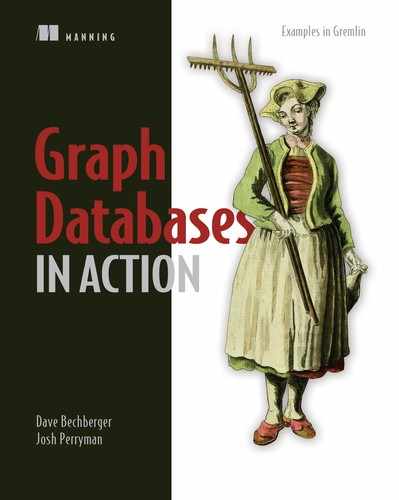Part 1. Getting started with graph databases
1.1 What is a graph?
Comparison with other types of databases
1.2 Is my problem a graph problem?
I’m still confused. . . . Is this a graph problem?
Four-step process for data modeling
2.3 Developing the whiteboard model
Identifying and grouping entities
Identifying relationships between entities
2.4 Constructing the logical data model
Translating entities to vertices
Translating relationships to edges
Finding and assigning properties
3 Running basic and recursive traversals
3.1 Setting up your environment
Starting the Gremlin Console, connecting to the Gremlin Server, and loading the data
Using a logical data model (schema) to plan traversals
Planning the steps through the graph data
Fundamental concepts of traversing a graph
Retrieving properties with values steps
Writing recursive traversals in Gremlin
4 Pathfinding traversals and mutating graphs
4.1 Mutating a graph
4.2 Paths
4.3 Traversing and filtering edges
Introducing the E and V steps for traversing edges
Filtering with edge properties
Performant edge counts and denormalization
5.2 Constructing our result payload
Projecting results instead of aliasing
Ordering results returned from a graph traversal
Grouping results returned from a graph traversal
5.4 Combining steps into complex traversals
Preparing the database server Instance
6.2 Connecting to our database
Building the cluster configuration
Setting up the GraphTraversalSource
6.3 Retrieving data
Using Gremlin language variants (GLVs)
Creating the Java method in our application
6.4 Adding, modifying, and deleting data
6.5 Translating our list and path traversals
Implementing recursive traversals
Part 2. Building on Graph Databases
7 Advanced data modeling techniques
7.1 Reviewing our current data models
7.2 Extending our logical data model
7.3 Translating entities to vertices
Translating relationships to edges
Finding and assigning properties
7.4 Extending our data model for personalization
8 Building traversals using known walks
8.1 Preparing to develop our traversals
Identifying the required elements
8.2 Writing our first traversal
8.3 Pagination and graph databases
8.4 Recommending the highest-rated restaurants
8.5 Writing the last recommendation engine traversal
Adding this traversal to our application
9.2 Building a subgraph for personalization
Reversing the traversing direction
Evaluating the individualized results of the subgraph
9.4 Implementing a subgraph with a remote connection
Connecting with TinkerPop’s Client class
Adding this traversal to our application
Part 3. Moving Beyond the Basics
10 Performance, pitfalls, and anti-patterns
10.1 Slow-performing traversals
What to do if you have a supernode
10.3 Application anti-patterns
Using graphs for non-graph use cases
Not using parameterized traversals
Using unlabeled filtering steps
11 What’s next: Graph analytics, machine learning, and resources
11.1 Graph analytics
11.2 Final thoughts
appendix. Apache TinkerPop installation and overview
